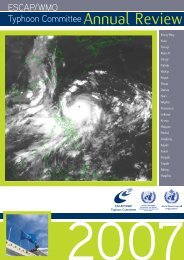TCAR - Typhoon Committee
TCAR - Typhoon Committee
TCAR - Typhoon Committee
You also want an ePaper? Increase the reach of your titles
YUMPU automatically turns print PDFs into web optimized ePapers that Google loves.
Advanced Objective Dvorak Technique (AODT),<br />
which is based on satellite observations (Dvorak<br />
Technique) from SSEC/UW-Madison (Space<br />
Science Engineering Center/University of<br />
Wisconsin-Madison). KMA’s typhoon analysis<br />
system has been in operation using AODT and<br />
producing statistical results. However, AODT is<br />
difficult to directly apply to the Northwest Pacific<br />
region, as it was initially developed mainly for<br />
hurricanes in the Atlantic.<br />
KMA developed a user-friendly web-based<br />
SATellite Image analysis System (SATIS) in<br />
2006, recently adding new functions that make<br />
it possible to search and download past typhoon<br />
analysis data from the database. SATIS is easier<br />
to use for analyzing tropical cyclones, especially<br />
for detecting similarities in the database. Once<br />
a typhoon name and its year are chosen, the<br />
search results can be saved in the user directory<br />
as text files. Fig. 34 illustrates a full search list<br />
of similar tropical cyclones from SATIS, which<br />
includes eye position, intensity (CI index), eye<br />
temperature, scene type, and radius maximum<br />
wind (RMW) along with image data.<br />
Fig. 34. Full search results of past data on tropical cyclones from SATIS<br />
Expansion and Improvement of KMA’s Upperair<br />
Observation Network<br />
Since 2003, KMA has been developing the KMA<br />
wind profiler network (KWPN), which comprises<br />
ten wind profilers, to improve the temporal and<br />
spatial resolution of its upper-air observation<br />
network. Beginning with Munsan and Gangneung<br />
in 2003, wind profilers were installed in Gunsan<br />
in 2004 and Masan in 2005. In 2007, five<br />
additional wind profilers were installed in Uljin,<br />
<strong>TCAR</strong><br />
CHAPTER 1 - TYPHOON COMMITTEE ACTIVITIES<br />
Chupungnyeong, Wonju, Cheolwon, and the Base<br />
Station of Oceanic-Meteorological Observation<br />
75km off the west coast of Korea, thus completing<br />
the KWPN.<br />
KMA currently operates ten wind profilers<br />
including one installed in Haenam by its research<br />
arm NIMR (National Institute of Meteorological<br />
Research). The horizontal resolution of the<br />
upper-air observation network in Korea has<br />
dramatically improved as a result, from 128 km in<br />
2002 to 74 km in 2007.<br />
Wind data up to 5 km are collected every 10<br />
minutes through the KWPN and are subsequently<br />
assimilated in the operational regional numerical<br />
model following an automated quality control<br />
process. These data help improve the accuracy<br />
of heavy rain, heavy snow and typhoon track<br />
predictions. Nine microwave radiometers were<br />
also installed at the wind profiler sites in 2009<br />
to collect information on a variety of upper-air<br />
elements such as wind, temperature, humidity,<br />
and liquid water content. KMA plans to further<br />
integrate its upper-air observation network to<br />
include a GPS observation network in addition<br />
to the existing wind profilers and microwave<br />
radars.<br />
2009<br />
111

















